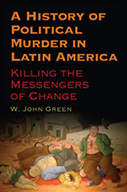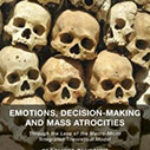A History of Political Murder in Latin America: Killing the Messengers of Change

Author: W. John Green
Publisher: Albany, NY: State University of New York Press, 2015. 382p.
Reviewer: Kimberly M. Pitts | September 2016
Students of Latin American studies are familiar with the numerous disappearances (desaparecidos) during the Pinochet dictatorship in Chile, the activism of the Mothers of the Plaza de Mayo in Argentina, Rigoberta Menchú Tum’s disturbing description of torture during La Violencia in Guatemala, and the butterflies of the Dominican Republic, the Mirabal sisters. In A History of Political Murder in Latin America: Killing the Messengers of Change, Latin American historian W. John Green takes on the ambitious task of identifying commonalities among Latin America’s various dirty wars, particularly focusing on political murder. In this well-researched book, the author demonstrates that while each country maintained its own unique version of dirty war, there were similarities that many scholars often overlook in their focus on a single geographical area.
The book, which is divided into two parts, focuses first on victims before turning to the various dirty warriors. As the title indicates, this book is a comparative analysis of political murder. In the Introduction, Green defines political murder and points out the penchant for victimization for those who threaten the status quo. “Messengers of change” throughout Latin America have been labeled subversives if their agenda does not coincide with the ruling elite. During the Cold War, that meant anyone who supported land reform, peasant’s rights or progressive ideas.
While the image of Che Guevara may come to mind when one thinks of a Latin American subversive or guerilla, the author shows that throughout Latin America in the 19th and 20th centuries, the definition of subversives was expanded to include many people one would normally consider benign, such as pregnant women, nuns and priests, and peasants. In fact, Green categorizes several types of political murder victims. As one would expect, the most overt subversives are revolutionaries and former guerillas. The author discusses revolutionaries and guerillas starting with Zapata and Villa of the Mexican Revolution, Sandino in Nicaragua, Salcedo in Colombia, and physicians turned guerillas Spadafora in Panama and Guevara of Argentina. Former guerillas with political ambitions were especially vulnerable to political murder. Politicians who promote a message of change are nearly equally vulnerable to annihilation as past rebels. Noting that Allende in Chile is the most famous example, the author further discusses the murder of several politicians in Colombia. Adding to the list of those likely to be targeted for political murder includes anyone advocating or promoting ideas of social justice particularly journalists, teacher artists and other intellectuals. Anthropologist Myrna Mack of Guatemala and journalist Bill Stewart in Nicaragua are among those discussed. With the spread of liberation theology throughout Latin America, it is no surprise that clergy are included in the list of potential political murder victims. Speaking out for the plight of the poor in El Salvador proved to be deadly for Archbishop Oscar Romero who was gunned down during mass and for four American nuns killed by the army. Members of the military, political, and criminal justice systems, who were deemed a threat to the elite by being amenable to change, often paid with their lives, as was the case of several lawyers from Guatemala, El Salvador, Colombia, Honduras and Peru who were executed. Concluding the list of individuals targeted for political murder are activists, many of whom are students, laborers or community leaders. Celebrity status did not protect those who promoted left-wing ideas. Rogelia Cruz Martínez, Miss Guatemala, succumbed to political murder as did several of the mothers and grandmothers of Argentina’s Mothers of the Plaza de Mayo. The Mirabal sisters of the Dominican Republic, who are today internationally recognized, were tortured and slain in a sugar cane field for their opposition to the Trujillo dictatorship. Sometimes even entire people groups can be a threat to the status quo. The author gives examples from Guatemala of hundreds of men, women, and children who were open fired upon in town halls because they were suspected of being activists.
After identifying those most likely to become victims of political murder, Green turns to a discussion on “wet work” or the manner in which political murder occurred. While not quite as consistent a pattern as identifying potential victims, he suggests a continuum of actors ranging from military to death squads. It is now widely known that the military was responsible for the majority of the deaths in some Latin American countries. The scorched earth policy of the Guatemalan Army, the “Parsley Massacre” along the Haiti/Dominican Republic border and the “Matanza” in El Salvador are just a few examples in which the military was responsible for killing numerous people, even entire villages of peasants. Covert military, police, and political party death squads all operated with the same goal of quieting subversives in order to retain power and economic position. The more overt paramilitaries may act with the military as in Nicaragua or be an arm of the elite as was the case in Chiapas with the Zapatista uprising.
The author ends the first part of the book with a discussion of victim’s bodies beginning with a description of the display of subversive bodies and the messages that are conveyed in public depictions. The careful attention given to the exhibit of Che Guevara’s slain body in Bolivia is noted. Menchú’s account of the public display of the mutilated and tortured bodies of her mother, brother and other Mayans and the fear and anger that one must control in being forced to watch as the army paraded the disfigured bodies about for all to see is recounted. The chapter continues with a description of various types of Colombian “cuts,” each given a nickname, such as the tie, in which the tongue is pulled out of an opening cut under the jaw. Even today slain bodies are dangerous. Forensic anthropologists who uncover clandestine graves may put themselves in danger if their findings are in opposition to official military accounts
The second part of the book, Justifications, Associations and Consequences, focuses on those who commit political murder and their reasons for engaging in such actions. Elites throughout Latin America, who shared the common goal of maintaining their status, employed various dirty warriors to control subversives. During the Cold War, potential rebels could be anyone who advocated change. For some elite, leftist-leaning political views such as land reform were tantamount to communism and meant a threat to economic status. The elite used the law, military, foreign connections and any other tool they had to protect their privileged position, even if it mean that innocent civilians were killed in the process. As the fear of communism spread throughout North and South America, elites throughout the region began to work together to stop the cancerous idea. Operation Condor is an example of cross-national cooperation to end subversive activity. The United States involvement in Latin America’s dirty wars has been well-documented.
Latin American military elite were trained in torture and unconventional warfare at the formerly-named School of the Americas (SOA) in Fort Benning, Georgia. Former Secretary of State Kissinger supported Chilean and Argentinean generals in their fight against communism and Ronald Reagan supported the plot against subversives in El Salvador, Nicaragua, and Guatemala. US corporations such as Coca-Cola, Del Monte, and Ford worked with the CIA in advocating for more capitalist-friendly governments in Latin America. Yet, Green points out that the role of the US government has not been consistent. At times, the US government supported actors, even military dictators, who were fighting subversives and at other times supported human rights. For example the Reagan administration supported the Contras in Nicaragua who are responsible for killing thousands of civilians while only a few years later the George H.W. Bush administration was more focused on human rights.
Green finishes the book with a consideration of the transition to democracy in the post-Cold War era. While Truth Commissions have been established in many Latin American countries, their focus has been on forgiveness and not prosecution. Argentina and Chile initially gave amnesty to military personnel, but it was later revoked and some military leaders were prosecuted, including Pinochet. The author notes that while political murder has waned even in areas where leftist policies have become institutionalized, the elite in Guatemala continue to rely on political murder to control those wanting to bring about change. In other countries, deadly military control has been replaced with police brutality. Unless impunity is addressed, the author asks what will become of future messengers of change.
Numerous books have been written about Latin America’s dirty wars, yet most tend to focus on one particular country. This book contributes to the field of Latin American studies and history, in particular, by providing a comparative analysis of political murder. The author not only demonstrates the proclivity for political murder, but argues that it occurs within democracies as well as dictatorships. Green acknowledges the United State’s involvement in Latin American political murder, unlike other authors, he does not solely blame the US government, CIA or SOA solely for human rights abuses, but recognizes that political murder existed before the Cold War and will likely to continue, although not the same extent. He further points out that not all regimes or governments turned to political murder to control the masses. Chile under Salvador Allende and Castro in Cuba did not employ the same control techniques; however those were both leftist governments. While it is important to acknowledge the atrocities of war so as not to allow such human rights violations to occur again, the chapter on slain bodies was a disturbing to read. One must question whether a detailed description of the process of decay adds to the message of this book.
A History of Political Murder in Latin America: Killing the Messengers of Change is a serious academic endeavor that is most likely to appeal to an audience within academia, particularly those in Latin American studies, history, and political science. The book provides important insights, even for those with a strong background in Latin American studies. For readers with a limited background on Latin America’s dirty wars or for those who need a refresher, the author includes a succinct, but detailed summary of the dirty wars of seventeen Latin American nations in the 63 page appendix. This book is a wealth of information and should be required reading for anyone working in Latin America.
Kimberly M. Pitts, Assistant Professor of Sociology, Campbellsville University


